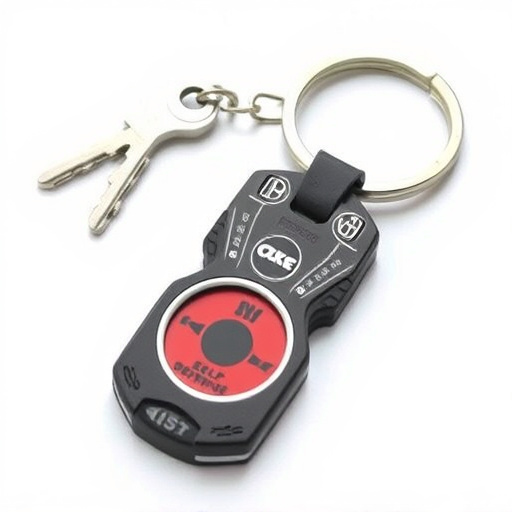Keychain alarms with panic buttons offer personal safety in emergencies but operate under complex legal frameworks globally. These devices, categorized as "less-lethal" tools, face age restrictions, deployment guidelines, and specific regulations like Legal Self Defense Keychain Regulations to balance self-defense rights with public safety. Users must stay informed about local laws regarding activation mechanisms, sound levels, and distribution to avoid false alarms and legal repercussions.
“Unleash peace of mind with a keychain alarm—a compact yet powerful personal safety device. This article explores the functionality and legal aspects of these handy tools, offering insights into their role as self-defense mechanisms. From understanding the panic button’s capabilities to navigating legal considerations and regulations, we guide you through choosing the right option. Learn about the balance between personal safety and legal restrictions on self-defense devices, ensuring you’re informed in today’s world.”
- Understanding Keychain Alarm Functionality
- Legal Considerations for Self-Defense Devices
- Regulations and Restrictions on Panic Buttons
- Choosing the Right Keychain Alarm: Safety vs. Law
Understanding Keychain Alarm Functionality
A keychain alarm with a panic button system is a compact, portable device designed for personal safety. Its primary function is to provide a discreet means of alerting others in case of an emergency, especially during situations where immediate help is needed and one cannot verbally communicate distress. When activated, the alarm emits a loud sound, often accompanied by flashing lights, to draw attention and signal danger.
The Legal Self Defense Keychain Regulations vary across jurisdictions, but these devices are generally considered legal tools for personal protection. Users can carry them as a form of self-defense, ensuring peace of mind while traveling or in potentially risky environments. The alarm’s panic button feature allows individuals to quickly trigger an alert, providing a simple and effective way to solicit help during emergencies, such as muggings, assaults, or getting lost.
Legal Considerations for Self-Defense Devices
When it comes to legal considerations, self-defense devices like keychain alarm with panic buttons operate within a regulatory framework that varies by jurisdiction. In many countries, personal safety devices are subject to specific laws and guidelines aimed at balancing individual rights and public safety. Keychain alarms, for instance, often fall under the category of “less-lethal” or non-deadly self-defense tools, which have distinct legal implications.
Regulations around these devices typically address factors such as age restrictions, permitted uses, and handling by law enforcement. It’s crucial to understand that carrying a keychain alarm may be restricted in certain areas, especially in places with strict gun control laws. Additionally, the use of panic buttons is subject to guidelines on when it’s appropriate to activate them to avoid false alarms or misuse, which can have legal consequences. Therefore, users should always be aware of and compliant with local regulations pertaining to self-defense devices.
Regulations and Restrictions on Panic Buttons
In many jurisdictions, the legal status of personal alarms and panic buttons, especially those incorporated into everyday items like keychains, is carefully regulated to ensure their responsible use. These regulations aim to balance the benefits of self-defense tools with potential misuse, ensuring that citizens can protect themselves while also maintaining public safety. Keychain alarm devices must comply with specific standards regarding sound levels, activation mechanisms, and even design features to prevent accidental triggers.
The restrictions on panic buttons often include age limitations for ownership and usage, as well as guidelines for when and where they can be deployed. Some regions have strict rules about the sale and distribution of personal alarms to ensure that individuals who may pose a risk to others are not equipped with these devices. Understanding local Legal Self-Defense Keychain Regulations is essential for anyone considering carrying or using such a device, ensuring compliance and promoting its intended purpose as a safe and effective tool for personal protection.
Choosing the Right Keychain Alarm: Safety vs. Law
When choosing a keychain alarm with a panic button system, it’s crucial to balance safety features with legal considerations regarding self-defense and regulations. While these devices can be a powerful tool for personal security, understanding local laws is essential to avoid legal complications. Some regions have strict regulations on the use of personal alarms, including restrictions on when and where they can be deployed. Users must ensure their chosen device complies with these rules to protect themselves legally.
For instance, certain areas may require individuals to register their alarm devices with local authorities or restrict their usage to specific situations like self-defense against an imminent physical attack. It’s important for buyers to research and comprehend these legal aspects to guarantee they’re utilizing the keychain alarm appropriately and within the confines of the law.
The keychain alarm with a panic button system offers individuals an accessible self-defense option, but it’s crucial to understand the legal and regulatory aspects surrounding these devices. As the use of personal safety tools evolves, staying informed about local laws regarding self-defense devices, including keychains with alarms and panic buttons, is essential. By considering the regulations and restrictions, users can ensure they remain within legal boundaries while gaining peace of mind. When choosing a keychain alarm, balancing safety features with compliance is key to selecting an effective and legally sound personal defense tool.
